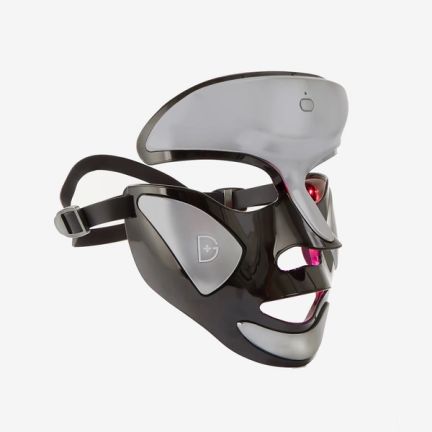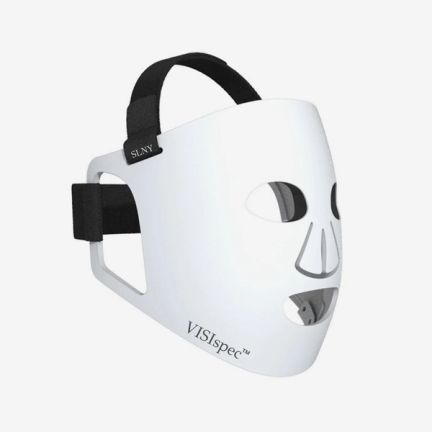
Words: Jonathan Wells
Let there be light! For many years, we’ve been smearing on salves and slapping on moisturisers. We’ve been rolling on eye serums and applying collagen creams. And for what?! Today, our pockets may be emptier, but our crow’s feet remain, as creased and crinkled as ever. Thankfully, we’ve finally seen the proverbial — and it glows a life-giving red.
LED light therapy is not a new type of treatment. But, during lockdown, when many spas and health centres were forced to shut down, brands pivoted into the production of personal gadgets — devices that could deliver doses of these wellness-giving wavelengths from the comfort of our own homes.
Today, there are many masks, wands and tools available to administer such light therapy at home. But could LED therapy be the key to de-ageing, how does it work — and is it for you?
What is LED therapy?

In the shortest, least scientific terms, it’s a type of light. LED stands for ‘light-emitting diode’ — and these semiconductors were first fired up by NASA in the 1960s, used as astronaut-friendly aids in plant-cultivation. During the same decade, researchers in Eastern Europe began applying to technology to medical areas, experimenting with the light and studying its effect on soft tissue and chronic joint pain.
These studies gleaned gleaming, promising results. And, over the course of the last half-century, medical experts have honed and harnessed LED tech to great effect. Whether it be wound healing, tissue growth or simple aesthetic concerns, these lights have become as ubiquitous in the wellness sector as cryotherapy, acupuncture and body contouring.
Purportedly, it works by having light penetrate your skin and trigger biological processes; stimulating receptors that help your body rejuvenate and boost cellular activity. Allegedly, LED therapy can double the rate of cell renewal, and also increase collagen production to reduce the appearance of fine likes or wrinkles. Or so it claims…
So, does it really work?

To some extent, certainly. Whilst the life-giving, skin-tightening benefits have likely been overstated, there’s certainly scientifically sound advantages to receiving LED therapy. Chief amongst them? That, despite its ability to treat acne, wounds and other skin maladies, it remains non-invasive.
Also, a review of studies by the National Institute of Health has found that many skin. conditions can be alleviated by a dazzling dose of LED light — everything from psoriasis to mild scarring. It may not be as comprehensive or clinical as other, more outwardly medial procedures (and it can take several treatment sessions, over the course of several weeks, to see results) but it is completely safe.
This is perhaps its biggest selling point. With no inherent danger, there’s little to lose. LED therapy doesn’t use harmful UV rays, which are notoriously detrimental to skin. And, unlike its harsher older brother — laser therapy — or controversial chemical peels, it doesn’t cause burns. Instead, it is utterly safe for all types and colours of skin.
So, is it for me?

That depends. There’s virtually no feeling, uncomfortable or otherwise, during an LED therapy session — save for a gentle, warming sensation. So there’s nothing to lose if you’re struggling with a skin condition and have exhausted every other remedial recourse. But, if you’re only trying it out in the pursuit of de-ageing, there may be other, less expensive options worth trying first.
However, if you do decide to give LED therapy a go, there are a couple of things you should be aware of. First off, red light therapy is your best bet for smoothening skin, and also for regulating pigmentation. Blue light is better for balancing the pH level of your skin, and for diminishing spots, acne and breakouts.
A combination of these wavelengths (yellow and purple also exist) will likely be deployed during a treatment — but it pays to ask a professional or specialist if you want to target or tackle something specific, such as dermatitis, eczema, rosacea or sun damage.
And there are plenty of professionals to ask. If you’re London-based, however, we can think of no brighter light in the LED world than FaceGym, which this month launched a customisable ‘Light Therapy’ booster with professional-grade LED mask. It’s a treatment that helps to stimulate collage and targets and treats multiple skin concerns — from hyperpigmentation to blemishes. Available at the brand’s Notting Hill and King’s Road studios, it takes just 15 minutes and is the ideal, affordable (£40) introduction to the world of LED therapy.
So, which to buy?

If, once you’ve tried it out at a spa or a studio, you find that LED therapy does work for you, there are plenty of at-home options to invest in. Some of these light-emitting inventions are wand-like things that you can hover above any problem spots. Others are screens or boards that will bathe your skin in multi-coloured brilliance. But the best are the masks; wearables that strap around your head and illuminate your face in close-up.
They’re convenient, easy-to-use and allow you do go about your day as normal — or thereabouts. Some are a little lacking when it comes to design — such as Solaris Laboratories’ ‘VISIspec’, a seemingly hockey mask-inspired design made from silicone and featuring blue, red, and the rarer yellow and purple LED lights — but others capture the future-facing style of the treatment.
Amiro’s alternative mask, the ‘L1’, is suitably chic. And, with a core energy density of 77mw/cm², it promises to repair your skin barrier almost completely in a week. It also has built-in eye protection, for added safety. But our favourite option is the ‘DRx SpectraLite FaceWare Pro’ from Dr Dennis Gross — a sci-fi slant on LED masks that’s both highly contoured to your face and compact enough to tote along on any potentially sun-burning travels.
Want more grooming solutions? Here’s how to fix a patchy beard…
Become a Gentleman’s Journal member. Find out more here.

Become a Gentleman’s Journal Member?
Like the Gentleman’s Journal? Why not join the Clubhouse, a special kind of private club where members receive offers and experiences from hand-picked, premium brands. You will also receive invites to exclusive events, the quarterly print magazine delivered directly to your door and your own membership card.






